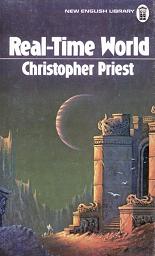
Real-Time World
Christopher Priest
158 pages
published in 1974
After finishing Camp Concentration I was in the mood for some New Wave science fiction and since I'd just bought this Christopher Priest collection of short stories this was as good a choice as any to read. Most of this I actually read while at the gym, on the treadmill -- short stories being ideal, quickly enough read in a forty minute session and not requiring too much sustained concentration like a novel would. Some of the stories in Real-Time World I'd read before, in Dutch translation, some were new to me. All but one of the stories were published between 1970 and 1974, perhaps the height of the New Wave, and all are very much of their time. As a writer Christopher Priest has always seemed more comfortable to me at novel length than at shorter lengths, which is also notable here.
The reason why I wanted to read these stories was because I knew how seventies they were, but as often when confronted with the reality of what I was looking for, I was disappointed with it. None of the stories were entirely satisfactory and although each was competently written, they were written to formula. You could see they were written to achieve a specific effect and how Priest achieves that effect and as a result most of the effect is lost. The first story for example, "The Head and the Hand", about automutilation as a form of performance art, with some graphic scenes including a final auto-guillotining which may have been shocking when first published, but certainly aren't now and without this shock effect the story falls apart.
Sometimes the effect is the story, as with "A Woman Naked", set in some unnamed, conservative future in which the female protagonist is forced to live outside civilisation, nude, depending on the kindness of family and friends to survive the waiting period before she can see the tribunal who will decide whether she can rejoin civilisation or has shown not to deserve its protection and hence remain fair game for rape. Not so much hitting you over the head with its moral as piledriving you into the ground with it, the whole setup is there for the final sentence as she confronts the tribunal: "the rape had begun".
There are some more traditional science fiction stories in this collection as well. "Breeding Ground" is a classic O. Henry story, while "Sentence in Binary Code" is a puzzle story and "The Perihelion Man" straight adventure. These are all enjoyable, if slight, the best being "The Perihelion Man", in which a retired against his will space pilot is brought back for one last mission. Unlike some of the other stories, these at least left me without a vague feeling of frustration.
The remaining stories -- "Fire Storm", "Double Consummation", "Transplant", "The Run" and "Real-Time World" -- are all stories of psychological conflict, less overtly concerned with effects and the better for it. Stories driven by internal conflict are of course somewhat harder to write than stories in which the hero has to overcome a physical challenge -- you need only to show the hero solving the puzzle, or overcome her environment, or outwit the villain. With psychological stories the conflict is harder to show, as seen in "Fire Storm". Captain Maast is the officer in charge of the orderly destruction of an unnamed enemy city, determined first to make sure it is in perfect order before he orders its destruction, then meticulously directing the artillery bombardment that'll destroy it, before being slowly drawn in by its death. We never get to know why this destruction happens and in such a ritualised manner, nor any great insight into why Maast is seduced into his death by it. All we have is the fascination with smashing down something beautiful, the way a small boy knocks down somebody else's sand castle.
What I liked about "Double Consummation" was not so much the story itself, as the assumptions that went into it. This really was an early seventies future, with Britain slowly depopulating, having to keep up its standard of living by increased consumption of luxuries and because one family could only consume to much, people went to living in multiple families, aided by chemical means. All taking place against a background of planned economy in which industry, workers and government work harmoniously together. Gender equality as well, despite the overtones of sexual liberalisation, is strangely absent, as it often is in socalled progressive science fiction of the period...
In a way, "Double Consummation" could stand for The Real-Time World as a whole. Well written, but dated, with its ability to shock or surprise sadly gone. It's a good example of what a certain part of especially British science fiction was like in the first half of the seventies, but with little added interest.
Contents:
- Introduction · in
- The Head and the Hand · ss New Worlds Quarterly 3, ed. Michael Moorcock, London: Sphere, 1972
- Fire Storm · ss Quark #1, ed. Samuel R. Delany & Marilyn Hacker, Paperback Library, 1970
- Double Consummation · ss The Disappearing Future, ed. George Hay, Panther, 1970
- A Woman Naked · ss Science Fiction Monthly v1 #1 ’74
- Transplant · ss Worlds of If Jan/Feb ’74
- Breeding Ground · ss Vision of Tomorrow Jan ’70
- Sentence in Binary Code · ss; Fantastic Aug ’71
- The Perihelion Man · nv New Writings in SF. 16, ed. John Carnell, London: Dobson, 1969
- The Run · ss Impulse May ’66
- Real-Time World · nv New Writings in SF. 19, ed. John Carnell, London: Dobson, 1971